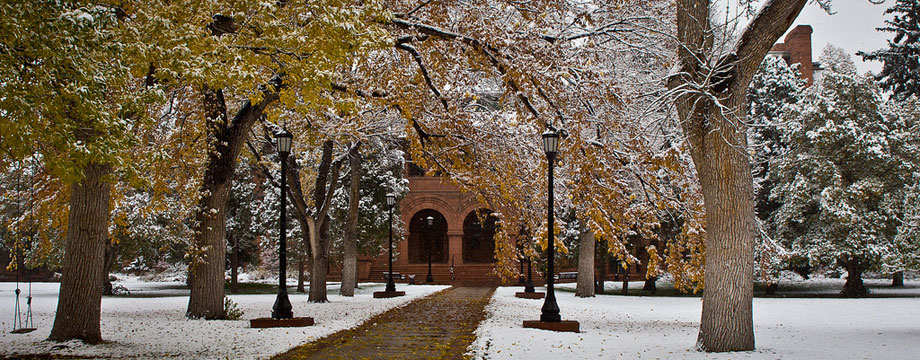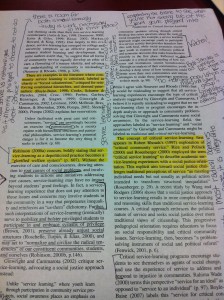It has been a week since journal club, and I have spent this entire week debating how best to journal/blog about the 90 minute discussion the CCE staff had about Tania Mitchell’s article. I’ve attached a photo of my notes from last Wednesday, mainly because I am incredibly excited by the academic nature of this work, and also as a visual to articulate the range of topics and ideas that were presented during our short discussion.
This article is incredibly relevant with regards to the changing structure and focus of our office — I think that Virginia says it best in her summary of our discussion,
“We need to assure student groups that we are here to support their efforts to do good work — and what’s deemed “good” is the proper focus of deliberative dialogue among, at the very least, CCE staff, student groups, and community partners.”
This can be clarified and built upon by explicitly stating that we will be transparent on the values we hold, particularly when naming something “service” or evaluating the work that we do. There are many ways to frame the meaning and impact of service, regardless of whether we’re calling it traditional or critical service learning. With this idea of measurable impact in mind, it is irresponsible to ignore the idea that “service-learning as a depoliticized practice becomes a glorified welfare system (51)”. It it our role as advisors and mentors to encourage students to think deeply about the motivations and impact of their community work. What is the desired outcome? How does sustainability and relationship-building factor into day to day activities? If students are not at this point in their service development, how can we encourage them to get there?
Reflection. We encourage student reflection in every step of their service and civic engagement journey. Through this reflection, we can encourage students to address root causes, question power dynamics and begin to delve into a broader understanding of social inequality and change. With this emphasis on personal reflection, guided through relationships with advisors and mentors, we hope that students will begin to realize the importance of forming deep and reciprocal relationships with their community partners. Through these relationships, reflection will flourish and only enhance a service experience. Additionally, we impress upon students the importance of sustainability, based upon our consensus as an office that “a social change orientation in the absence of a commitment to sustainable relationships is irresponsible.” This follow-through often requires a multi-pronged effort, which brings us back to the first question of framing the meaning and value of service! Through coalition building, we are able to (1) support all developmental levels of civic engagement, (2) address multiple binaries, and, (3) work on multiple objectives simultaneously.
Our discussion was very free form and responded mainly, in my mind, to current projects around re-structuring student organizations and service at Colorado College. Although these are important things to discuss, I do not want to omit the incredibly hard work Virginia and Jessica put into developing questions to guide our discussion.
- How do “traditional service-learning (service to individuals)” and “critical service-learning (service for an ideal)” differ from one another? (What differences make the difference so to speak?)
- Is the distinction useful?
- Why pursue one model of service-learning rather than the other? Decision criteria?
- In the contexts of the CCE, CC, and Colorado Springs, what are the challenges of pursing one model rather than the other?
- Is critical service-learning too audacious for CC and Colorado Springs? If not, how can we “transform social justice theory into service learning practice” (page 62)? What would that look like here at CC and in Colorado Springs?
- With which model is your work at the CCE currently aligned (rhetoric versus reality)?
- Are student development and community change mutually exclusive (theory versus practice)?
- Do we currently support the complementary relationship among service activity, course content, community needs, and student outcomes? If so, what are some specific examples? If not, how can we?
- Do we currently ensure community input? Integrate community (page 58)? If so, what are some specific examples? If not, how can we?
- What do relationships based on “connection” look like? Have you seen this in your work here or anywhere else? How can we avoid “artificial homogenization” and foster “authenticity” instead (page 59)?
Readers, it is your choice. Respond to my thoughts, respond to any of the questions posed by Virginia and Jessica, dig deeper! This is not a one-time blog post but a continued conversation among engaged citizens.


